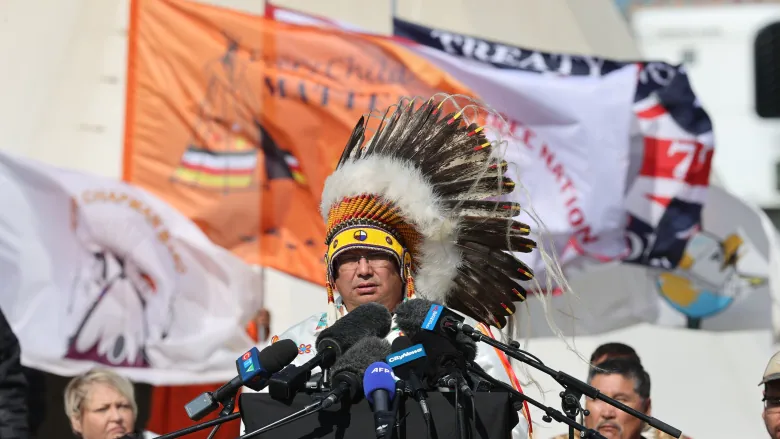By Caelan Beard, Anastazia Csegeny, & Kate Paterson
Content Warning: This case may be distressing and awaken memories of past traumatic experiences and abuse.
The National Indian Residential School Crisis Line provides 24-hour crisis support to former Indian Residential School students and their families toll-free at 1-866-925-4419.
Individuals impacted by the issue of Missing and Murdered Indigenous Women and Girls are encouraged to contact the MMIWG Crisis Line toll-free at 1-844-413-6649.
First Nations, Inuit and Métis seeking immediate emotional support can contact the Hope for Wellness Help Line toll-free at 1-855-242-3310, or by online chat at hopeforwellness.ca.
On Sept. 4, 2022, 11 people were killed and 18 were injured in a mass stabbing at James Smith Cree Nation and Weldon, S.K. Myles Brandon Sanderson, 32, was identified by Saskatchewan RCMP as the sole person responsible for the killings. Sanderson died in police custody after experiencing what authorities described as “medical distress.”

“Pickup” stories
This case study begins by looking at “pickup” stories that had been written about those killed during the Sept. 4 stabbings. Death knock or pickup stories are when a journalist goes to the scene or home to get a story about someone who’s died. Their job is to try to understand who the person was and “pickup” a photo to be used in an article. Doing this makes many journalists feel uncomfortable or queasy, with concerns that they’re intruding on grief or being insensitive. However, studies have shown that families often appreciate the stories.
There are several benefits to a well-done pickup story, including that they create community, can be therapeutic for victims’ families to talk about their loved ones and allow families to control the narrative, including how their loved one is remembered and/or portrayed after death. For example, which photo runs with an article can be important:
“When a reporter speaks personally to the family and asks them which photograph they would prefer to run with the tribute story of their loved one, families retain some measure of control.”Additionally, Susan Clairmont, Hamilton Spectator reporter for 20 years, says that pickup stories “’help humanize people’ so that they are more than just a statistic.”
In the case of the stabbings, many reporters tried to obtain pickup stories following the stabbings, but were met with a challenge: James Smith Cree Nation had issued a media ban that prevented any reporters from entering the reserve. Journalists had to face an ethical challenge of reporting about the case while respecting the community’s wish for privacy.
Both while the media ban was in place and after it was lifted, journalists faced an additional challenge when trying to obtain pickup stories: they didn’t know anyone. While guest hosting the podcast Shortcuts, Zak Vescera, from the Saskatoon Star-Phoenix Reporter, commented that it seems that “about once a year, a horrific tragedy in Saskatchewan” occurs, citing examples such as the 2016 Colten Bouschie shooting, 2018 Humboldt Broncos bus crash, and 2021 discovery of 751 unmarked graves near a former residential school.
These stories attract international media attention, which is typically followed by large numbers of journalists – who have no prior relationships with the community – descending on the place.In this case, Vescera says, “the murders brought the eyes of the world to a community of about 1,900 people.”
This approach shows a lack of care in reporting, as journalists descend on the community, typically stay for a brief time to get their story, and leave. This is even more problematic because “the more vulnerable a crime victim is as the unexpected subject of a news story, the more the values of compassion and dignity from a care-based approach should trump traditional journalistic values.”
Journalists need to practice a greater ethics of care, which includes doing follow-ups, fostering positive relationships with communities, and reporting on them outside of massive tragedies. These communities have important stories that need to be told respectfully and responsibly.
Coverage of the Perpetrators
Coverage of Myles and Damien Sanderson, alleged perpetrators at the time of initial coverage, centred around mental health, criminality, and violence, and used those individual factors to frame them as one-dimensional, irredeemably bad characters.
For example, one headline from the Canadian Press read “Past drug, alcohol use had caused stabbing suspect to lose mind: parole document”. Later in that article, it showed that was a quote from Myles, who told the Parole Board of Canada that regular use of drug and hard alcohol would made him “lose (his) mind” and get angry.
Similarly, a Calgary Sun opinion piece by Brian Lilley used emotionally charged language including that Myles “brought death and carnage”, had “past violent convictions”, and that “he was free to terrorize his community”.
This type of coverage also deflects blame from systemic issues by remaining hyper-focused on the individual perpetrators and excluding relevant context. For example, mental illness may “co-occur with crime and violence as a result of a complex set of preceding factors that include a history of abuse, violence, poverty, homelessness, and discrimination”. Myles Sanderson grew up in a violent home. It is known that lack of care or poor quality of care may in extreme cases lead to more severe symptoms or behaviours and to an increased possibility of harming oneself or others.

Amongst the reporting that came out of the Saskatchewan stabbings, there is an example of reporting that (we) believe encompasses an ethics of care, by Ashleigh Stewart of Global News. Stewart stayed in the community for two weeks, sticking around after most other journalists left to cover the funeral of Queen Elizabeth II (the Queen died four days after the stabbings).
Stewart tried to have compassion for community members, and expressed it in simple yet meaningful ways, such as not asking them solely about the story, but asking “how are you?” The length of time she spent in the community – still not extensive, but longer than the other journalists – allowed her to create a broad range of coverage that went beyond the simple, most sensationalist details of the story to include more in-depth stories and coverage of funerals that she was invited to.
Being in the community for slightly longer and working to build trust and familiarity with the community members eventually led to Stewart getting an exclusive story from Skye Sanderson, widow of Damien Sanderson. Skye’s story included much that had not been previously reported on, including that Skye called RCMP 24 hours before the murders, that Myles had previously talked about killing 10 people, and that Skye believed Damien was a victim as well, not a perpetrator.
Later, the evidence shifted that Damien did not kill or inflict harm on anyone. He actually stopped his brother from killing one person and was then killed by Myles. “If it wasn’t for Damien, I would’ve been dead. He saved my life. After he left, I right away called 911,” an injured victim explained.
This story shows two things: 1) the need for journalists to act with an ethics of care that includes being constantly willing to learn and change, and 2) the important role that families can play in shedding light on – and potentially changing – the narrative.
As journalists and communicators, it’s imperative that we keep this in mind. “Fair, responsible and careful media coverage” is necessary in order to “vastly improve perceptions, care, and treatment of mental-health issues in Canada”. Media coverage that actively works to dispel stereotypes, includes context, keeps focus on systemic issues over individual blame, and gives attention and care to stories that matter, thereby has the potential to have a positive impact – or at the very least, do no harm – while reporting on these stories.
Discussion Questions
- How would you apply an ethics of care when reporting on this case?
- This case shows that the media has the power to alter people’s perceptions about a story, and about the individual(s) involved. How can media cover stories in a way that balances the public’s right to know while providing context on sensitive and complex issues? How might this change for breaking news vs. developing stories?
- To what extent do you think journalists need to be informed about the communities they cover? How does closeness with a community play a role in the coverage that communities (and their stories) receive?
- What perspectives is it important for journalists to listen to when trying to determine the focus or ‘angle’ for a story? Why? How does the exclusion or inclusion of certain perspectives affect this case?
Bibliography
Arriagada, Paula, Tara Hahmann, and Vivian O’Donnell. “Indigenous people and mental health during the COVID-19 pandemic.” Stats Canada, June 2020.
Berry, Sarah, and Rob Whitley. “Representing risk: Criminality, violence, and mental illness in Canadian news-media reporting.” In Covering Canadian Crime: What Journalists Should Know and the Public Should Question, edited by Chris Richardson and Romayne Smith Fullerton, 346-365. Toronto: University of Toronto Press, 2016.
Brown, Jesse, and Ashleigh Stewart, hosts, “Shocking Revelations On The Saskatchewan Stabbings.” Canadaland Shortcuts (podcast), September 29, 2022.
Brown, Jesse, and Zak Vescera, hosts, “A Manhunt in the Prairies.” Canadaland Shortcuts (podcast), September 8, 2022.
Global News. “James Smith Cree Nation calls for local tribal policing after stabbing rampage.” Video press release, September 8, 2022.
González-Ramírez, Andrea. “Where’s the Media Attention for Missing Indigenous Women?” The Cut, September 24, 2021.
Harding, Robert. “Problematic Representations of Indigenous Issues in Media.” The Canadian Bar Association, 2022.
Lilley, Brian. “Three justice system failures with deadly consequences.” Toronto Sun, September 15, 2022.
Malone, Kelly Geraldine. “Past drug, alcohol use had caused stabbing suspect to lose mind: parole document.” The Canadian Press, September 6, 2022.
Mathewson, Joe. 2022. Ethical Journalism : Adopting the Ethics of Care. Abingdon, Oxon ;: Routledge. https://doi.org/10.4324/9781003140337.
Smith Fullerton, Romayne, and Maggie Jones Patterson. “The traditional ‘pickup’ or ‘death knock’ story: Its role, its value(s), and the impact of social media.” In Covering Canadian Crime: What Journalists Should Know and the Public Should Question, edited by Chris Richardson and Romayne Smith Fullerton, 23-42. Toronto: University of Toronto Press, 2016.
Stewart, Ashleigh. “Exclusive: Saskatchewan stabbing suspect’s wife says she called RCMP 24 hours before murders.” Global News, 2022.
Vescera, Zak. “Closure, grief and a killer’s capture on James Smith Cree Nation.” Saskatoon Star-Phoenix, September 10, 2022.
